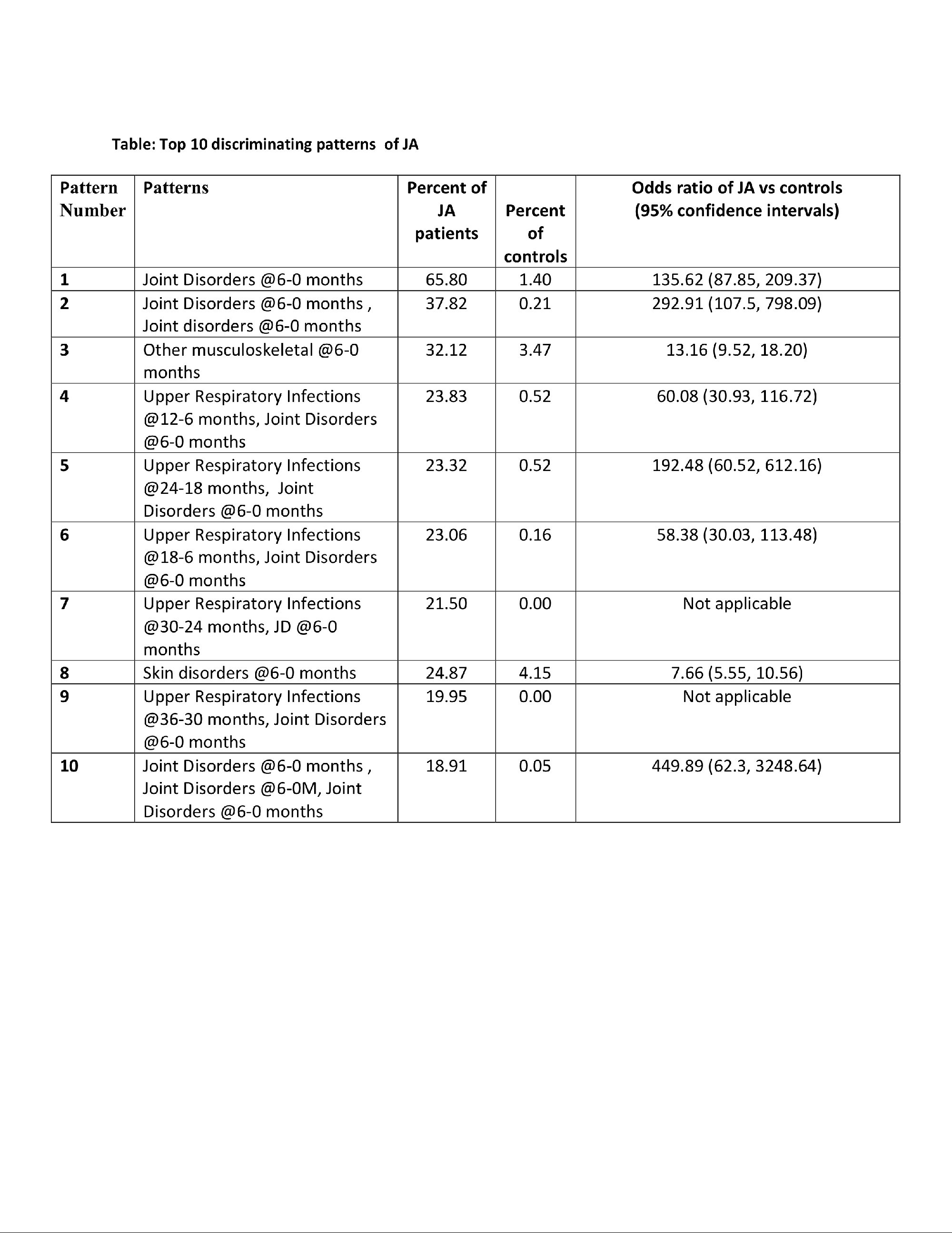Session Information
Session Type: Abstract Session
Session Time: 4:00PM-5:30PM
Background/Purpose: Increases in health care visits precede the first diagnosis code for inflammatory arthritis (IA) by an average of 5 years in adults, but it is unknown if this occurs in children. Reports of symptoms before juvenile arthritis (JA) are usually < 6 months but could be longer for some. We hypothesized that patterns of visits that precede JA diagnosis differ from those in non-JA controls. We aimed to discover visit patterns preceding JA diagnosis in health administrative databases (HAD).
Methods: Populations: JA patients diagnosed from 1983-2012 in the only paediatric rheumatology centre in Manitoba, Canada were linked to provincial population-based HAD. Controls were matched 5:1 to JA patients by age ± 1 year, sex, health regions, JA diagnosis dates (index dates for controls) and did not have an IA code ≤ 18 years old in HAD. Visits since birth or immigration until diagnosis/ index dates were used for analysis (1980-2018). Data preprocessing: Diagnosis codes (International Classification of Diseases versions 9-CM and 10-CA) from all inpatient and outpatient visits were clustered into clinically-relevant categories using open-source Clinical Classification Software. Visits were examined in 6-month intervals from birth until diagnosis/index date. Analysis:Prefixspan, a sequential pattern mining (SPM) machine learning algorithm was applied to visits of JA cases and controls to detect patterns (temporal sequence of events) preceding diagnosis/ index dates. We modified the algorithm to assign lower weights to encounters that were more remote to diagnosis than those closer in time to diagnosis (time fading). JA and control patterns were compared by relative percentages (of patterns) and odds ratios (of JA compared to controls) thresholds. Patterns were screened and evaluated for face validity by the clinical team.
Results: 386 JA patients (65% females) were matched to 1930 controls. Median age of JA patients at diagnosis was 8 years. JA subgroups: oligoarticular 42%, polyarticular 28%, spondyloarthropathy 13%, others 17%. We studied 98649 visits: 20946 JA, 77703 controls. JA patients had more visits compared to controls, respectively with median (25-75thpercentile) of 19.5 (7.0-38.5) versus 15 (5-31) general practitioner visits, and 15 (4.5-35) versus 8 (1-23) specialist visits. ICD codes were classified into 101 chronic diseases, 116 acute diseases/ poisoning/trauma categories. We detected 544 discriminating patterns. Patterns of JA were detectable ≤3 years pre-JA diagnosis. The most common 10 patterns that discriminated between JA patients and non-JA controls, before diagnosis are presented (Table).
Conclusion: Machine learning methods detected healthcare encounter patterns more likely associated with JA relative to controls in a population-based cohort, ≤ 3 years before diagnosis. Visits preceded IA codes, providing an insight into heterogeneity in JA presentations and potential associated events before JA. Once validated, our method may be used to: i) identify potential JA patients for earlier management, ii) define disease cohorts for outcome studies at a population level in HAD.
To cite this abstract in AMA style:
Lim L, Hryhoruk C, Marrie R, Peschken C, Leung C, Lix L. Machine Learning Detected Healthcare Encounter Patterns Leading to Diagnosis of Juvenile Arthritis in a Population-Based Canadian Cohort [abstract]. Arthritis Rheumatol. 2023; 75 (suppl 9). https://acrabstracts.org/abstract/machine-learning-detected-healthcare-encounter-patterns-leading-to-diagnosis-of-juvenile-arthritis-in-a-population-based-canadian-cohort/. Accessed .« Back to ACR Convergence 2023
ACR Meeting Abstracts - https://acrabstracts.org/abstract/machine-learning-detected-healthcare-encounter-patterns-leading-to-diagnosis-of-juvenile-arthritis-in-a-population-based-canadian-cohort/

